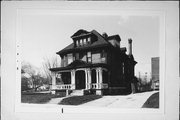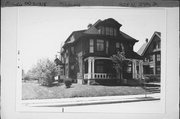Property Record
925 N 29TH ST
Architecture and History Inventory
| Historic Name: | Hattie & Moritz Meissner House/ Ben Begnall House |
|---|---|
| Other Name: | |
| Contributing: | Yes |
| Reference Number: | 30318 |
| Location (Address): | 925 N 29TH ST |
|---|---|
| County: | Milwaukee |
| City: | Milwaukee |
| Township/Village: | |
| Unincorporated Community: | |
| Town: | |
| Range: | |
| Direction: | |
| Section: | |
| Quarter Section: | |
| Quarter/Quarter Section: |
| Year Built: | 1897 |
|---|---|
| Additions: | |
| Survey Date: | 1984 |
| Historic Use: | house |
| Architectural Style: | Neoclassical/Beaux Arts |
| Structural System: | Balloon Frame |
| Wall Material: | Clapboard |
| Architect: | Eugene R. Liebert |
| Other Buildings On Site: | |
| Demolished?: | No |
| Demolished Date: |
| National/State Register Listing Name: | Concordia Historic District |
|---|---|
| National Register Listing Date: | 7/30/1985 |
| State Register Listing Date: | 1/1/1989 |
| National Register Multiple Property Name: | Multiple Resources of West Side Area |
| Additional Information: | Fred T. Liebert was the builder and William Jaeger was the Mason. Fred T. Mueller also worked on the house. As of 1931 Elsie Diemen ran a boarding house here. Mortiz Meissner was a German-born Jewish merchant who operated a wholesale-retail boot and shoe business, the Garden City Shoe Co., at the time he built this residence. The Meissner family lived here through 1903. "Built in 1879, this German Baroque-style home was designed by architect Eugene Liebert. While many of Liebert's architectural commissions were for brick structures, this house has a rectangular shape and balloon frame with clapboard siding and a hip roof. Baroque elements include the two scalloped pediments, a front dormer, and an elaborate front porch with clustered columns and brackets. Each pediment has an ornamental roundel at its center and the columns are embellished with decorative capitals and festoons. The first owner, Moritz Meissner, was a German-born Jewish merchant who operated a wholesale and retail boot and show business, the Garden City Shoe Co. at the time he built this residence. In the 1920s, a fire occurred on the upper floors causing water damage to the ceiling in the dining room. The fire necessitated the removal of a turret on the south end of the house. The two original dormers on the south side of the second floor were also removed and a large dormer was constructed in the 1940s to accommodate a fire escape that has since been removed. The Meissner House later served as a rooming house with furnished rooms and, for a period of time, was divided into seven apartments with up to 16 people living there. A reminder of the multi-units in the house include numbers and letters identifying units on the first and second floor doors and locks and bolts in unusual places. Today, original art work by home owner and artist, Michael Westcott, fill the home's walls." Spaces & Traces Open House Tour, Historic Milwaukee Inc., 2012. |
|---|---|
| Bibliographic References: | Milwaukee Ethnic Houses Tour, City of Milwaukee Department of Development, 1994. Milwaukee Historic Buildings Tour: West End, City of Milwaukee Department of City Development, 1994. MILWAUKEE JOURNAL SENTINEL 6/9/1996. Spaces & Traces Open House Tour, Historic Milwaukee Inc., 2012. |
| Wisconsin Architecture and History Inventory, State Historic Preservation Office, Wisconsin Historical Society, Madison, Wisconsin |


